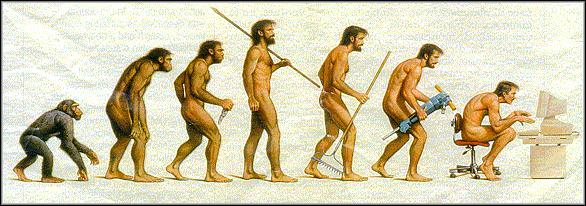One Small Step for Genotype, One Giant Leap for Phenotype
 The DNA difference between humans and chimpanzees is very small, currently estimated somewhere around 1%-4%, depending on which source you read, and what exact pattern matching algorithm you use for the comparison. This small evolutionary step in the DNA code of our ancestors was obviously enough to build a whole different brain. To paraphrase on Neil Armstrong: one small step for genotype, one giant leap for phenotype.
The DNA difference between humans and chimpanzees is very small, currently estimated somewhere around 1%-4%, depending on which source you read, and what exact pattern matching algorithm you use for the comparison. This small evolutionary step in the DNA code of our ancestors was obviously enough to build a whole different brain. To paraphrase on Neil Armstrong: one small step for genotype, one giant leap for phenotype.Last week, following a discussion thread on BlogCatalog’s Popular Science group, I began to wonder what is the most significant human feature that kept monkeys on trees and launched us to the moon. Sure, we have a bigger brain and there are a lot of differences, but what is the single most important human feature, the one that makes the biggest difference, the one that helps us build cars, airplanes and spaceships, while apes’ biggest achievement so far is using a stick to fish termites?
Maybe human native tribes living today can help me here. Although they have the same DNA and the same potential as modern societies, many of these tribes are still living in the Stone Age, with zero chance of escaping Earth’s gravity anytime soon. So it must be some unused cultural-encouraged potential they’re missing…
hmmm… I wonder... maybe it’s writing? Both monkeys and native tribes, failed to develop written language. Writing enables accumulative and effective knowledge transfer between people and across generations. It also enables exceeding short-term 7 elements memory capability, making complex mathematical calculations possible.
What do you think?
~~~
p.s. Give my two kids half a donut each and they’ll probably fight over who got the hole.








14 comments:
Read Guns, Germs and Steel by Jared Diamond, if you hadn't already.
http://en.wikipedia.org/wiki/Guns,_Germs,_and_Steel
The monkey can't choose what to do. It will act as it is "programmed" to, so his "choice space" in very small. For us humans, this "choice space" is almost endless. Maybe this 1% in the ganes that we have is the ability to choose.
@Inbar,
Thanks, I'll add that to the stack of books near my bed, but it may take me a while to read it since it goes to the bottom of the stack which is currently 33cm in height (I just measured it).
@Miky,
hmmm... maybe... just one problem - I don't believe in free will (see article "Red or Blue - Is Free Will Just an Illusion?").
You might also want to read Next by Michael Crichton.
I have just finished reading it, and although it isn't one of his best books IMO, it's certainly relevant to the subject of this blog entry.
PS. Does your minkey have a license?
dude, its one simple trait that created that leap, no matter how many genes form it: Imagination.
It created the wheel, and the 9th symphony, and assembly, and the Monaalisa. Seems trivial, but in my opinion - thats all it took. Despite it receding appreciation in a strictly logic based culture. Imagination.
p.s: southpark, ImaginationLand Trilogy, a must see....
cheers,
s
@in adrua tendit,
Thanks, I’ll add this one too.
@s,
Yes, imagination is an important drive force, but do you think the 9th symphony, and assembly would survive without being written down?
I totally agree with you Uri about the difference between us and the monkeys, and the writing that separates us. There is something so magical in the written words, there is power in it beyond the intelligence we have, or have not. A very good point you made here, worth thinking and pondering, and perhaps writing about it :)
And there I was believeing it was the opposable thumb... ah, well.
Uri,
What really happened eons ago at about the time of the 'split' is that one very smart monkey realized that the future would be sitting in a dark room, staring at a lighted screen and pushing buttons.
He opted for simply sitting there, watching the sun set as he ate a banana.
Uri, move "Guns Germs and Steel to the top of the pile and also read Diamond's book, "Collapse".
No, the monkey can choose what it wasnts to do in the social context who it will hang out with, what gestures it will use to communicate with other monkeys, it just has no use for tools. Maybe apes are more socially developed than we are, just not great tool users.
Humans do wonderful things to each other. Guns, Germs, and Steel and Collapses are both excellent books.
I think you'd really like "Next" by Michael Crichton. It's funny too. I bet if you look at it you'll put it on top of your stack...
Predictive intelligence + language + transcription = elaborate tool production and use over space and time.
Multiply those possibilities over time and you get nearly exponential growth.
Thank you all for making the stack of books near my bed a little bit higher...
The only difference between a chimpanzee and a human is not just in their brains. All monkeys have four hands and no feet! A feet should have no opposing thumb. All four hands of a monkey or chimp have opposing thumbs and therefore these cannot be called feet. Scientists often say that is only a small step between a human and an ape. How far away this is from the truth!
Post a Comment